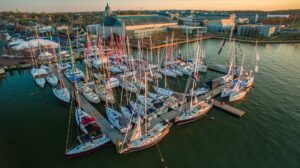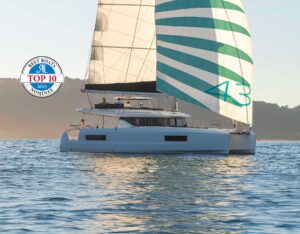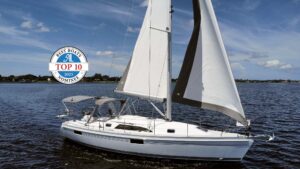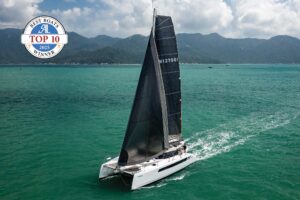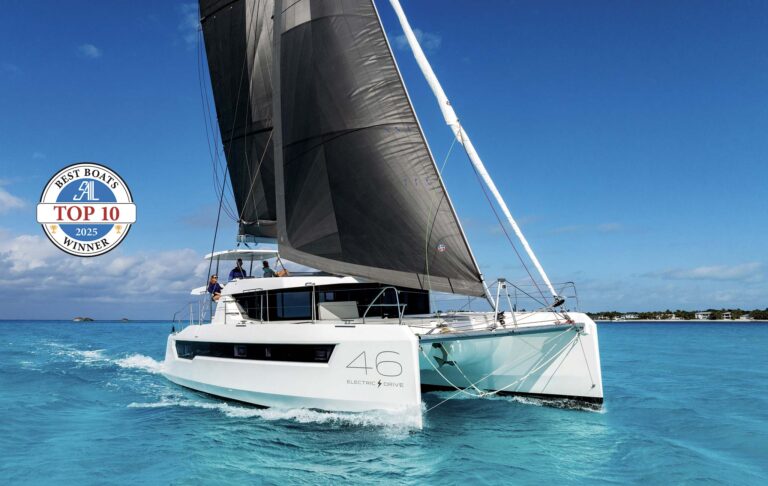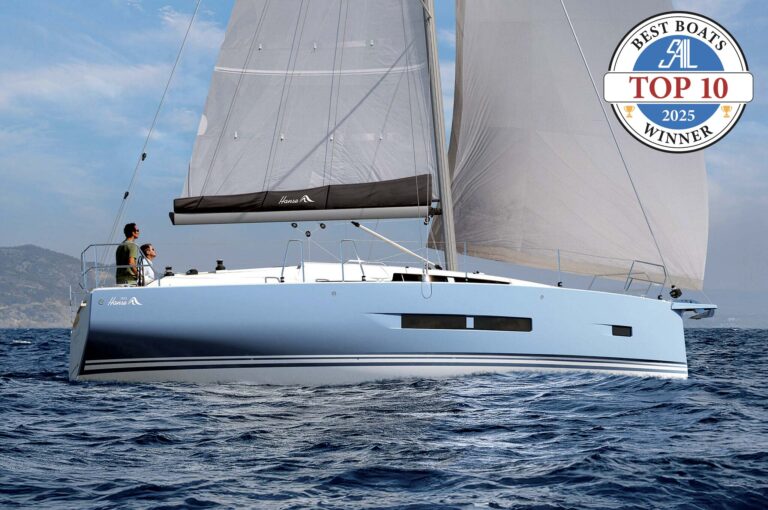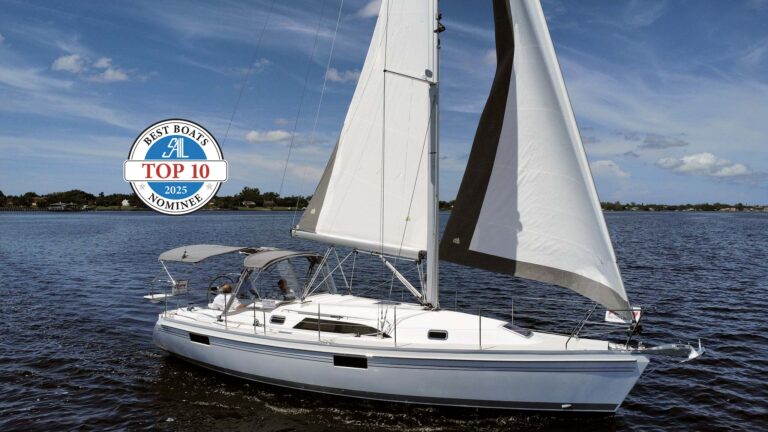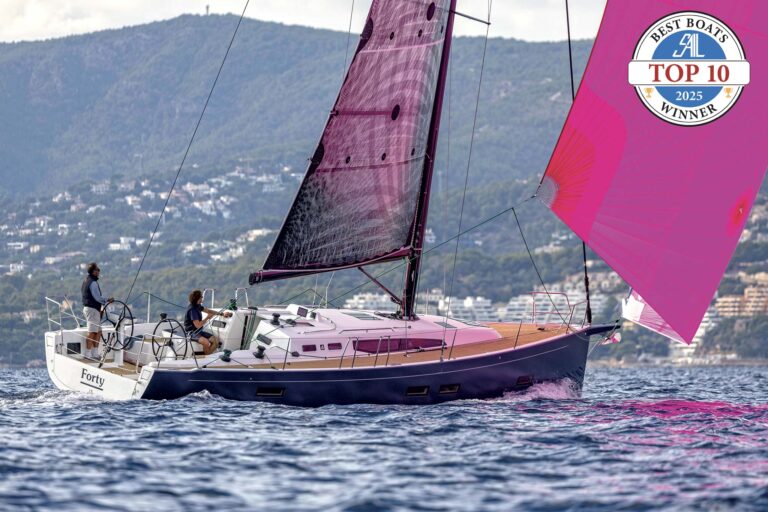
If the new Beneteau Sense 50 doesn’t attract attention at the fuel dock with its dramatic lines, it certainly will cause a stir when it crabs sideways into position alongside the pumps. Of all the interesting vessels at the Annapolis boat show this past fall, this one generated the most buzz within the crowd.
[brightcove videoid=”3986660190001″ playerid=”3793114819001″ height=”355″ width=”600″]
CONSTRUCTION
The hull is composed of a solid hand-laid biaxial E-glass laminate. A grid and pan laminated within the hull reinforce the structure and carry rig loads. The deck is resin-infused with a balsa core. The bolt-on keel is of cast iron. The test boat was equipped with a 5ft 7in shoal-draft keel. A deeper 6ft 11in keel is also available.
ON DECK
Boarding the Sense 50 from astern, you get the impression you are stepping onto a stage. The cockpit is—in a word—vast, with hinged helm seats that lift out of the way to provide plenty of space for boarding, swimming or entertaining. The wide open-scoop stern might be a liability when running before following seas, but a transom rises from a housing to reduce the visual drama and provide additional security.
The decks are wide and flat, with grabrails right where you need them. The boom is high, so you need to climb a couple of mast steps to flake the mainsail in its lazyjacks. The rig is conventional, proven and simple, with wire rigging and no unusually shaped sails.
Much of the sail area of this boat is in the foretriangle, which can be filled with an array of different headsails, depending on an owner’s sailing needs. Our test boat had the standard genoa, which is nearly as large as the main. We also carried an optional jib topsail, which jacks up the horsepower significantly. A standard or asymmetric spinnaker should eliminate any need to run the engine as you cruise downwind on gentle summer days.
ACCOMMODATIONS

Step below through the electrically powered companionway door, and you’ll find a bright, comfortable, stylish space for getting out of the weather. The cabin is quite wide, thanks to the boat’s substantial beam, but there were enough grabrails that I was able to safely swing like a monkey through the saloon while underway at full speed in the light chop. The ride below was smooth, easy and quiet, and the central drop-leaf table has padding to lean against when the boat heels. This table also conceals a television, which rises electrically to its viewing position. A nice nav table to starboard serves as a comfy place to sit back and kick up your feet for a rest.
The galley is along the starboard side in the European style and includes a double fridge/freezer, an icemaker and a microwave oven. In addition to the central drop-leaf table, there is a convertible cocktail table that rises electrically and unfolds to make a large dining table. Somebody at Beneteau loves electric motors. Even the cabin shades are powered. It’s a very pleasant technological indulgence.
The overhead and hull ceilings are covered with cushioned vinyl. The upholstery is of matching leather. The light teak joinery is neat, precise and perfectly finished to a high CNC-woodworking standard.
The interior does not seem especially large, until you open the door to the forward cabins and see the entire space at once. Moving forward, there’s a sizable pilot cabin with a double berth to port and a pleasant office to starboard. The comfortably large master cabin is forward, with a head that includes a separate shower compartment. Beneteau offers an optional layout with a single-berth cabin in place of the office and an extra single cabin aft in place of the standard stowage space.
UNDER SAIL
Boats with wide transoms and sharp bows have been around long enough that we all know how fast they are. But somehow it still surprises me when a boat with motorboat-size accommodations and shoal draft performs so well. A lovely breeze building from 12 to over 20 knots gave me plenty of wind with which to explore the Sense 50’s range of abilities. In the lighter stuff, the working sails produced a respectable 7 knots to windward with little heeling. The broad beam and slight chine make the boat feel stiff and secure, so guests can remain comfortable. I measured tacking angles well under 90 degrees on our test boat, which had yet to be tuned.
When we changed up to the big jib topsail, with the wind blowing 18 and gusting to 25, the boat responded by accelerating easily to its 9-knot hull speed. We were a bit overpowered on close reaches, but we were having such fun we didn’t care. Neither did the boat, which remained easy to control and felt secure. Helm pressure remained light, and an abundance of electric winches made trimming sails easy.
UNDER POWER
Though the Sense 50 is a fine sailing boat, its performance under power is what will fascinate most sailors. Heading out for our test sail we threaded a very narrow marina entrance with a scant foot of clearance on either side. We later returned the same way—going backwards! The boat pirouettes easily, like a twin-engined catamaran, in its own length.
What makes this possible is Beneteau’s new Dock & Go drive system, comprised of a rotating sail drive unit and a bow thruster that are both controlled by a single joystick at the helm. Push the stick in any direction to control the thrust. Twist it to change your heading.
I found the system easy to master, much like flying a radio-controlled model airplane. However, it’s important to maneuver at low speed to avoid the effect of water flow over the underwater foils. (Switching from conventional propulsion to the Dock & Go system also locks the boat’s twin rudders, so that you are maneuvering using thrust alone.) After about 15 minutes of practice, an average skipper should be ready for almost any docking challenge.
Powering in a straight line, I measured 8.1 knots of boatspeed running at a cruising rpm of 2,600. Full throttle brought the boat up close to hull speed.
CONCLUSION

With its combination of excellent sailing performance, easy handling under power and luxurious accommodations, the Beneteau Sense 50 redefines the optimum capabilities of a large performance cruiser. Other builders will soon start scrambling to catch up.
SPECS:
LOA: 49ft 15in
BEAM: 15ft 9in
DRAFT: 5ft 5in (std) 6ft 9in (shoal)
DISPLACEMENT: 31,195lb
FUEL/WATER (GAL): 110/140
DESIGNER: Berret Racoupeau/Nauta
BUILDER: Beneteau

